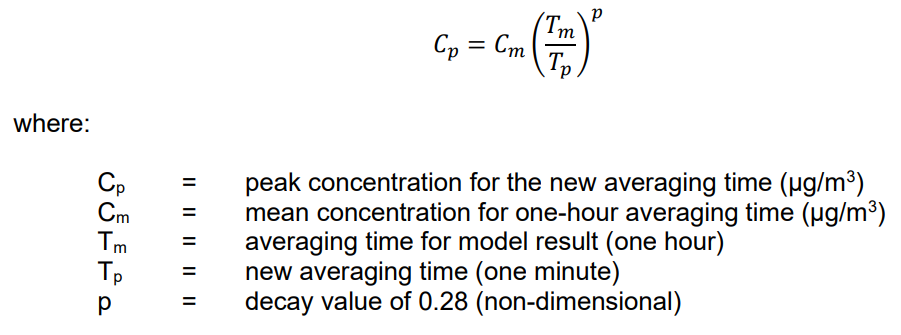- Air Homepage
- Alberta Air Quality
- Air Quality Dispersion Modelling
- Air Quality Assessment Report
Air Quality Assessment Reports on emissions, meteorology, and dispersion
The air quality assessment report assesses environmental impacts of industrial emissions.
Decoding industrial emissions reports with scaling factors and sulfur spikes - Are you nervous about dealing with the maze of Alberta's AAAQOs and sub-hourly scaling factors, knowing that one error could lead to costly regulatory delays? Get the exact, technical blueprint you need to confidently calculate and report your industrial emissions, from maximum SO2 plumes to tricky TRS odour control!
Hourly and super-hourly emissions are calculated and, along with their predicted concentrations, compared to provincial rules, such as the Alberta Ambient Air Quality Objectives (AAAQOs) and Guidelines (AAAQGs).
Whether it's a short-term (one-hour) or long-term (annual) modelling being examined, the report emphasizes the need to accurately model emission rates and conditions. Even when maximum emissions may exceed air quality standards, typical emissions must stay compliant.
 Industrial emissions and the environment
Industrial emissions and the environmentThe Alberta air quality guideline explains sulphur modelling and odour management, showing when different sulfur compounds need to be assessed collectively as Total Reduced Sulphur (TRS). Based on hourly meteorological data, AERMOD and other dispersion models are used to predict concentrations. However, managing concentrations may also mean meeting sub-hourly guidelines so even brief spikes don't compromise air quality.
Whether you're concerned about air quality, sustainability, or regulatory compliance, this description is for you. Emission management and environmental protection will be affected by future growth and technology. Reasons to read your Air Quality Assessment Report:
- Find out how air quality standards may assist with public health.
- It simplifies the discussion of pollutant dispersion.
- Find out how the local environment is affected during periods of typical and maximum emission rates.
- Sulphur and odour management sections explain how emissions cause pollution.
- Find out how emissions, pollution policies, and growth are related.
- Learn how industrial operators stay within air quality laws.
- There's real-world relevance to this report pertaining to industry practices.
Air Quality Assessment Reports - Brief notes for British Columbia
It's important to consider changes in emission rates over time when assessing compliance with air quality objectives. For short-term (1-hour) concentrations, use the maximum emission rate observed during the entire simulation. When calculating long-term averages (8-hour, 24-hour, annual), use the maximum emission rate corresponding to the averaging period (e.g., annual average emission rate for annual average predictions).
Alberta emission scenarios, odor control, and regulatory compliance
As part of the assessment process, the director needs to approve the modelling results. There are examples of tables showing maximum predicted concentrations, concentration maps, model control files, and other relevant data in Appendices A and B of the Alberta dispersion modelling guideline.
Additional reporting may be needed if your assessment is complex. The submitted output should explain how the assessment objectives were met, explain the methodology used, and ensure that the director can use it effectively. To avoid delays or rejection, it's important to provide enough detail so the reviewer understands the assumptions and steps taken in the assessment.
Air quality modelling in Alberta might require typical emission scenarios alongside upset cases and maximum emissions. The purpose of this document is to clarify how to interpret and use modelling results based on typical emission rates under a variety of circumstances. When modeling at maximum emissions doesn't meet air quality standards and certain sources have significant differences between typical and maximum emissions, typical scenario modelling is needed. If typical emissions don't exceed air quality goals:
- Review and adjust approval limits to fit typical emissions.
- Take into account future growth and technology.
When typical emissions go over goals:
- Check out the facility design and pollution control.
- Plan for future growth and technology to reduce emissions.
In dispersion models, emissions and environmental or meteorological data are input, and concentration or deposition values are output. Concentrations are usually measured in micrograms per cubic meter (µg/m3), while monthly deposition rates are measured in milligrams per square meter (mg/m2/month). Gas concentrations can also be expressed in parts per million (ppm) or parts per billion (ppb). Using the formula:
[ppm] * 40.8862 * molecular weight = [µg/m3]
...you can convert ppm to µg/m3 and back as needed.
 Reporting requirements for assessments
Reporting requirements for assessmentsTo help deal with atmospheric turbulence, concentrations are often averaged over specific time periods like an hour, 24 hours, 30 days, or an annual average. Hourly values above the 99.9th percentile for each receptor in each year are usually ignored for air quality assessment reports. When assessing substances without specified air quality objectives, use Ontario, British Columbia, or Texas values.
A director must be consulted if predicted concentrations exceed air quality objectives. a variety of environmental agencies (such as the Alberta Energy Regulator or other provinces) provide guidance on meeting air quality goals.
Hourly averaging periods are usually considered the minimum duration of concern in air quality models. In order to determine concentrations to compare with AAAQOs and AAAQGs, hourly meteorological data is commonly used. When calculating a sub-hourly AAAQO or AAAQG from hourly data, a scaling factor must be applied.
The scaling factor for air quality modelling can be approximated as follows (Ontario 2016):

For instance, a 30-minute AAAQO or AAAQG is calculated by multiplying the modelled hourly value by 1.21.
Unless a sub-hourly AAAQO or AAAQG is needed for odour management, the standard 99.9% tolerance should be used. In Section 7.1.2, additional guidance is provided for calculating sub-hourly Ambient Air Quality Guidelines (AAAQGs) for odour management purposes.
For odour management, like odourant 'A', it's acceptable to eliminate the top 43 values (99.5% tolerance per 8760 independent hourly values per year at each receptor). Infrequent events shouldn't be taken into account.
Alberta has a few additional notes on specialized sulphur modelling in Alberta. Various sulfur compounds like H2S, CS2, COS, and others should be input into the model as Total Reduced Sulphur (TRS). For modelling, you should sum the masses of each TRS species if you have measurements or estimates.
Compliance with air quality dispersion modeling in Saskatchewan
In order to show how a facility might affect the environment, you have to submit the results to the ministry. Tables and figures show maximum predicted concentrations, distances from the source, etc. Make sure the reviewer understands the methodology and assumptions made during the assessment.
 The maximum pollutant concentrations
The maximum pollutant concentrationsAERSCREEN calculates concentrations hourly, whereas other models can average over different times. To compare one-hour concentrations with longer-term averages, like 24-hour or annual averages, conversion factors can be used. Air quality standards are assessed based on these factors.
In dispersion models, concentrations are usually expressed in µg/m3, while air quality standards are often expressed in ppb or ppm. The ideal gas law equations are used to convert between these units.
Air quality should be modelled using five consecutive years of hourly Meteorological data. Maximum concentrations are to be reported with exceptions that apply to hourly averages above the 99.9th percentile. Each receptor point's maximum concentration should be recorded, and tables and maps showing the relevant maximum concentrations should be provided.
Include isopleths (curves of equal concentration) on the maps, indicating the frequency and location of exceedances above a certain threshold concentration. The model should be run five times, once for each year, and the highest annual average for each receptor should be plotted.
Figures of isopleths should be overlaid on a map showing topography and sensitive receptors and at least 90 percent of which is covered by the entire modelling domain. Making sure modeling methods and results comply with any applicable limits or objectives is the modeller's responsibility.
A conversion factor is recommended when comparing peak one-hour average concentrations from refined models like AERMOD with standards for shorter averaging times, like half-hour or 10-minute standards. To convert one hour's concentration to minutes, use a power law equation:

Using this equation, you can adjust the concentrations to match different averaging periods for accurate comparisons.
At Calvin Consulting Group Ltd.,
We value your time. Whether you need approvals or to address potential emergencies, you need quick, reliable solutions. That's where our air quality dispersion modelling comes in.
We're more than just experienced; we're leaders. Top environmental agencies like Alberta Environment and Environment Canada trust us with complex air quality assessments.
To meet provincial and national standards, we use site-specific meteorological data and expertly crafted models like AERMOD and CALPUFF. You'll save yourself time and headaches if you keep your facility safe and unobtrusive.
Make air quality compliance easy for your company. Barry at Calvin Consulting...

...can help. Let us handle everything, so you can focus on what you do best.
Clean air is our Passion...Regulatory Compliance is our Business.
Compliance with environmental standards is determined based on air quality assessment reports.
Models like AERMOD are used to predict pollutant concentrations. These calculations help us compare the expected consequences of emissions with Alberta Ambient Air Quality Objectives (AAAQOs) and Guidelines (AAAQGs). This article explains how to interpret modeling results and when to apply typical or maximum emission scenarios.
Future growth, technology, and pollution controls all affect long-term sustainability. This page is for those interested in air quality and regulatory compliance.
Do you have concerns about air pollution in your area??
Perhaps modelling air pollution will provide the answers to your question.
That is what I do on a full-time basis. Find out if it is necessary for your project.
Have your Say...
on the StuffintheAir facebook page
Other topics listed in these guides:
The Stuff-in-the-Air Site Map
And,
Thank you to my research and writing assistants, ChatGPT and WordTune, as well as Wombo and others for the images.
OpenAI's large-scale language generation model (and others provided by Google and Meta), helped generate this text. As soon as draft language is generated, the author reviews, edits, and revises it to their own liking and is responsible for the content.

New! Comments
Do you like what you see here? Please let us know in the box below.